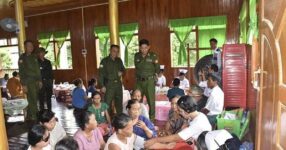
Myanmar soldiers help clean up after typhoon that killed over 380
NAYPYITAW, Myanmar — Soldiers carted away debris Monday, September 23, 2024, from parts of military-run Myanmar where floods and landslides from Typhoon Yagi and monsoon rains earlier this month left more than 380 dead and 89 missing, according to reports in state-run media.
The death toll in Myanmar was higher than the combined total for all the other Southeast Asian countries affected by the devastating typhoon, which killed almost 300 people in Vietnam, 42 in Thailand and four in Laos, as well as 21 in the Philippines, according to the ASEAN Coordinating Center for Humanitarian Assistance.
Senior Gen. Min Aung Hlaing, the head of Myanmar’s military government, said during a weekend ceremony to accept cash donations for flood-affected areas that 384 people were killed and nearly 150,000 affected by the floods, the state-run Myanma Alinn newspaper reported.
Efforts to bring aid and tally the casualties and damage have been slow in part due to difficulties communicating with the affected areas.
Myanmar is wracked by a civil war that began in 2021 after the army seized power from the elected government of Aung San Suu Kyi. Independent analysts believe the ruling military controls much less than half of the country’s territory.
Another state newspaper, the Global New Light of Myanmar, reported Monday that military, police and fire brigade personnel were taking part in the cleanup of flood-hit areas, including in the capital Naypyitaw, as well as Shan States and Mandalay and Bago regions. They also were helping to repair roads and bridges.
It said the cleanup work was being done at Buddhist monasteries, schools, hospitals, clinics and government offices, and that medical teams were providing health care services.
According to a report issued Friday by the United Nations Office for the Coordination of Humanitarian Affairs — UNOCHA — an estimated 887,000 people, including those already in displacement camps, were affected in 65 townships in central and eastern Myanmar,
There was widespread destruction of homes, water sources and electricity infrastructure, and schools, religious site and farmlands “have been severely damaged or completely collapsed,” the report said.
There was an urgent need for drinking water, food, medicine, clothing and shelter, the report said. (AP)



